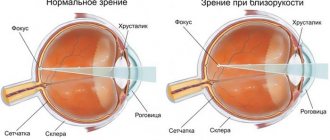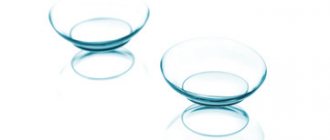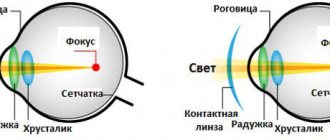Myopia is the most common vision defect. A person suffering from myopia, without glasses or lenses, has to bring objects as close to their eyes as possible in order to see them clearly. A slightly less common pathology is farsightedness. People with farsightedness, on the contrary, when looking at an object or reading, are forced to move the book or object in question away from their eyes to a greater distance: sometimes it even reaches the distance of an outstretched arm.
With age, the lens of the eye loses its elasticity, and the ability to adapt and focus on objects located at different distances gradually deteriorates. The first signs of age-related deviations are emerging difficulties with reading. The person notes that old glasses or lenses according to an old prescription no longer allow you to comfortably read text and view objects at different distances. To read and look into the distance normally, he has to use different glasses.
It is in this situation that glasses with progressive or multifocal lenses will help. These lenses are designed to correct vision at different distances.
Benefits of progressive lenses
The manufacturer of these glasses highlights a number of advantages, because of which it is recommended to purchase them if there is a doctor’s indication:
- the patient does not need to buy several pairs of glasses at the same time;
- a gradual change in diopters from minus to plus when looking from top to bottom, there is no sharp jump in the image, so the patient does not experience eye pain or headaches when viewing images;
- the glass looks solid, with the naked eye it is impossible to notice the transition from one lens curvature to another;
- the ability to choose the material from which the lens is made (glass, plastic, polycarbonate);
- the possibility of additional coating of glasses, for example, to protect against ultraviolet radiation, dirt, water;
- different cost of technical equipment, which can be spent by absolutely any patient.
The use of progressive glasses greatly simplifies people's lives, allowing them to function in everyday life without having to buy a lot of optical aids.
What are progressive glasses?
Eyeglasses equipped with progressive lenses can provide clear vision at all distances. The refractive power of light in them changes gradually from top to bottom. The upper part of the glass allows you to see clearly at a long distance. The lower half of the lenses corrects farsightedness, that is, improves near vision. Between these two optical zones there is a rather narrow part of the glasses, which is responsible for image quality at an intermediate distance.
Different areas of the lenses have different curvature, therefore their ability to refract light rays also differs. These glasses are very comfortable. They replace two pairs of optical products for people with presbyopia and eliminate the need to remove the optics when shifting their gaze. These lenses also have disadvantages:
- The optical zones have a small area, so you can see a clear picture only through a relatively small part of the glass.
- The image produced by the peripheral area of the lens is blurry. This is typical for all glasses, including progressive ones.
- The line of sight may not pass through the part of the glasses through which you need to look at the moment. So, for example, while going down the stairs, a person looks down and the floor is visible through the area of the lens responsible for near vision, that is, for reading. You need to get used to this.
All these factors have caused many patients to tolerate progressive glasses. Because of this, they have to purchase glasses with bifocal lenses. They have only two optical zones without an intermediate one. Another “minus” of them is their lack of aesthetics. Variable focus optics do not have these disadvantages. Let's find out how these glasses work.
Advantages and disadvantages
Before the advent of progressive lenses, ophthalmologists prescribed another similar type of glasses - bifocals.
Bifocals
Compared to them, multifocal lenses have the following advantages:
- More aesthetically pleasing (no visible reading “windows” at the bottom), outwardly they look like regular lenses.
- Availability of a medium distance zone.
- The ability to use one pair of glasses instead of three for different focusing areas.
- A clearer image, especially with individual “fitting”.
- Smooth transition between areas of different dioptres.
The disadvantages of such glasses include the following:
- High price.
- The complexity of manufacturing and the need for highly qualified ophthalmologists.
- Adaptation period.
- Limitation of use due to existing contraindications.
The time it takes a patient to adapt to progressive glasses depends on the correctness of the prescription and the individual characteristics of the visual organs.
Progressive lenses with control prism
Let us turn to the patent issued for progressive lenses with a control lens [2], according to which the lens has a horizontal prism with an ever-increasing power, with a base inward or outward, which is set between the distance and near zones. The goal of this design is to create a horizontal prismatic effect of at least 2.0 pdpt; Prism power is defined as the difference between the horizontal prismatic effects created at the distance reference point (D) and at the near reference point (N). According to the patent, the prism power is between 2.0 and 5.0 dptr, and ideally should be between 2.5 and 3.5 dptr. This prism power, as stated in the patent, when oriented with the base inward will have a beneficial effect on the quality of vision of patients with exophoria in near vision, and a lens with a prism base outward will be useful in patients with esophoria in near vision.
The patent also states that this invention in the field of spectacle lenses may be effective in controlling myopia in children. Studies examining the effectiveness of slowing the progression of myopia have shown that addition alone may not be effective for all myopes. This is explained by the fact that when working visually at close range, both accommodation and convergence can be overloaded. And one of the goals of the invention under discussion is to create a mechanism that allows one to simultaneously balance accommodation and convergence in order to prevent or at least delay the onset of myopia in a child or adolescent. In addition, the patent states that when selecting such lenses for presbyopia, adding a prism to the near segment with the base inward can give rest to the oculomotor system by relieving convergence insufficiency.
In Fig. Figure 1 shows sections along the horizontal meridians of such a progressive lens with a prism base inwards on the right eye. For clarity, cross-sectional views through the lens are presented on the right, the front and rear surfaces in the distance zone appear flat, and a gradient increase in thickness is observed towards the nose. It can be seen from the figure that the eye, as it turns downward from the intermediate distance zone, will look gradually through the increasing thickness of the lens until it reaches the near zone.
Rice. 1. Horizontal cross-sections of a lens illustrating progressive addition, with a horizontal prism added at the bottom of the progressive lens.
In Fig. Figure 2 shows how the power of the prism increases from the distance reference point (D) to the near reference point (N) as the eye moves downward. As follows from the prism power profile, in the distance zone there is no prismatic effect, and as we move towards the near zone it increases to 3.5 prdptr. The optical profile of the lens, which is not shown here, will of course be determined by the amount of addition.
Rice. 2. Adding a horizontal prism to increase its power in intermediate and near vision areas in a progressive lens (Essilor)
Price
The price of progressive lenses depends on the following factors:
- a manufacturer of a foreign brand of glasses will cost significantly more than a Russian one;
- the wider the transition area between plus and minus on the lenses, the higher the cost;
- the narrower the thickness of the glasses, the higher their cost, but the quality will be at a high level;
- additional capabilities of lenses (optical aid for right-handers and left-handers, driving a car);
- frame cost.
To avoid negative effects on the organs of vision, you must first undergo an ophthalmological examination and an assessment of the condition of the eyeballs.
The rehabilitation period is significantly reduced, and it will be easier for the patient to get used to new glasses. It is necessary to follow a number of rules according to which this optical device is used. During the adaptation period, you should perform daily exercises to make life easier and quickly get used to the glasses.
How to choose progressive glasses
Selecting progressive glasses takes more time than selecting an optical system for nearsightedness or farsightedness. The ophthalmologist must check distance vision, calculate the addition for near vision, and measure the distance from the pupil to the bridge of the nose (and for each eye separately). Special, custom-made glasses are the most convenient and high-quality device for treating age-related farsightedness.
Initially, frames for progressive glasses were limited: the progression corridor had to fit, so the frame had to be wide. Today you can buy progressive glasses of almost any shape.
Patients also have the opportunity to receive individual frames with progressive lenses, which will be made according to specific parameters. When making lenses and frames, the distance from the pupil to the back surface of the lens, the curvature of the plane in relation to the face, the dimensions of the frame and the radius of its curvature are taken into account. The most accurate measurements will allow you to create perfectly comfortable glasses and ensure high vision at any distance.
Manufacturers of progressive lenses:
- "BBGR" This company offers customers lenses that adapt to the vision characteristics of right-handers and left-handers. BBGR's own research shows that the connection between visual response and body position is important, and therefore the company's products take these features into account. The products have quality certificates.
- "Rodenstock". The company specializes in producing glasses that improve near vision acuity.
- Seiko Optical Europe. The products of this manufacturer are intended for drivers of light and heavy vehicles. Their progressive lenses are suitable for viewing objects at medium and long distances, which increases confidence behind the wheel.
- Shamir Optical Industry Ltd. This company produces lenses for people with farsightedness and myopia.
- Essilor International. The manufacturer uses Nanoptix and SynchronEyes technologies. To improve the quality of products, 4D technology is used, taking into account the peculiarities of the mutual work of the eyes.
Progressive lenses that completely correct astigmatism in near vision
It is a well-known fact that, except in cases where the eyes do not accommodate, such as aphakia, the cylindrical component of the lens refraction, which corrects astigmatism in distance vision, does not correct astigmatism in near vision. Because the spectacle lens is located in front of the eye, the astigmatism in the beam emerging from the lens is not the same as the astigmatism in the beam that comes from the first principal point of the eye.
For example, let's take a spectacle lens with the following parameters: Sph +5.00 diopters; Cyl +2.00 D; ax 90°. Let it be located 15 mm in front of the first principal point of the eye, so that the astigmatism measured in the plane of the lens is: Cyl +2.00 diopters; ax 90°. At the same time, astigmatism in the beam that reached the eye is Cyl +2.41 diopters; ax 90°, which is the actual astigmatism of the eye (Fig. 5). If we trace the paraxial beam of rays from the near point of clear vision, located 33.33 cm in front of the lens (which we consider a thin lens), the astigmatism in the beam entering the eye will be Cyl +2.20 D; ax 90°, that is, we get an undercorrection of approximately +0.25 diopters. along a cylinder in this meridian.
Rice. 5. Eye astigmatism (AH) for distance vision (a) and near vision (b) in case of its correction with a lens with parameters Sph +5.00 diopters; Cyl +2.00 D; ax 90°
To completely correct astigmatism of the eye, it is necessary to ensure that the astigmatism in the beam of rays reaching the eye is Cyl +2.41 diopters; ax 90°. Taking as a basis that the eye is able to cope with the minimum requirement of accommodation in the vertical meridian, the beam of rays in the horizontal meridian should have the following parameters: (+2.06) + (+2.41) = Cyl +4.47 diopters; ax 90°. This corresponds to a beam leaving the lens in the horizontal meridian with a Cyl value of +4.19 diopters, so the lens power that completely corrects the astigmatism of the eye for near vision at a distance of 0.33 m will be: Sph +5.00 diopters; Cyl +2.19 diopters; ax 90°. We see that we have to increase the value of the cylindrical component for distance if we want to completely correct astigmatism in near vision.
The difference between the cylinder values for distance and near can be found using a simple formula [5]. We increase the near cylinder by –2d (L + A) / 10%, where d is the distance from the lens to the first main point of the eye, L is the distance to the near point of clear vision, expressed in diopters, and A is the value of the addition assigned to the patient. In the case presented in Fig. 5, d = 15 mm, L = –3.00 diopters, A = 0 (since no addition was assigned). Thus, it turns out that the cylinder for near needs to be increased by [–2 × 15 × (–3.0)] / 10 = 9%. Nine percent of +2.00 is +0.18; this value is close to what we got from ray tracing.
Obviously, changing the value of the near cylinder is usually resorted to in cases of high values of astigmatism. But even so, the changes made are not particularly different from those required for prescription compensation, when the actual optical power differs from the prescription due to the pantoscopic angle of the frame or the patient's facial angle. Since the production methods of lenses with a free-form surface allow you to set the optical power in steps of one hundredth of a diopter, such lenses can easily compensate for the cylindrical component for near. It may even be necessary to slightly change the direction of the cylinder's axis for near, since some eyes may rotate during convergence when looking at close objects.
Today, some major lens manufacturers offer spectacle lenses in which the cylinder power and even its axis in the near segment are different from the distance segment. Although this specialized form of correction has been available for many years through the use of bifocal lenses, the advent of free-form surface technology today makes it possible to specify different cylinder and axis values in the distance and near zones of progressive spectacle lenses.
Back in 2007, the Essilor company patented a lens in which the cylinder values for distance and near are different [6].
Contraindications
Glasses with different diopters are contraindicated for patients who have only one form of visual acuity impairment. That is, for people who have only myopia or only hypermetropia. People with poor vision do not need to wear glasses for hyperopia if they can see objects up close without the use of an optical device.
There are other contraindications to wearing an optical device:
strabismus, since at the same time both eyes cannot focus on the upper or lower point of the optical device, their gaze may fall into the blind spot of the glasses; discrepancy between diopters for different eyes, for example, the right organ of vision has -4 diopters, and the left - -1.5; cataract is clouding of the lens due to the accumulation of insoluble protein fractions; the use of glasses in this case is irrational, since the image will still not be clear; Nystagmus is an involuntary movement of the eyeballs that does not allow one to focus on one point. If you have the above diseases, it is recommended to first undergo treatment for the primary disease, only then select glasses
For example, with strabismus, it is possible to perform surgery on the extraocular muscles to restore the symmetrical orientation of both organs of vision
If you have the above diseases, it is recommended to first undergo treatment for the primary disease, only then select glasses. For example, with strabismus, it is possible to perform surgery on the extraocular muscles to restore the symmetrical orientation of both organs of vision.
Terms of use
According to people, wearing progressive glasses takes some getting used to. To do this, you should start using them on weekends or during vacation.
It is important to completely abandon old glasses and always wear only progressive optics
In a calm environment, you need to learn to focus your gaze on the book in your hands, and then move it into the distance, looking at objects in the back of the room.
It is especially difficult at first to go up and down the stairs. Quite often people simply lower their gaze, but when using progressive lenses this is not enough; you also need to tilt your head a little to look through the middle zone.
Types of corrective optics
Glasses that a doctor prescribes for myopia are indicated by a “-” sign. Such lenses have a biconcave shape and are called diverging. They scatter the light rays that fall on them, which allows you to adjust the focal length. Thus, the image of an object, which was focused in front of the retina without a lens, is transferred directly to the retina itself. As a result, the visual analyzer correctly perceives the information received, and the person sees clearly. The greater the scattering power of the lens, the greater its “minus”.
Glasses for farsightedness work on the opposite principle. Converging lenses are placed in them. Their shape is biconvex, which helps to “gather” light rays into a beam to reduce the focal length. This is exactly what the farsighted eye needs, because with farsightedness, the image is focused behind the retina. Such a lens is called positive and has a “+” sign. The doctor selects lenses according to the degree of farsightedness - the stronger it is, the greater the “plus” of the lens, and the greater its collecting ability should be.
Contraindications
Progressive lenses are not recommended for patients with anisometropia (different eye refraction, that is, a difference in diopters). For cataracts, wearing glasses is ineffective due to clouding of the lens.
Nystagmus does not allow the use of progressive spectacle lenses due to instability of the pupil in the progression channel, which can result in the gaze falling into areas of distortion. With strabismus, it is impossible to maintain parallel lines of movement of the eyeballs in the main directions of progressive glasses, that is, near, middle and far.
Representatives of some professions need to select progressive glasses with special care. These are librarians, cosmetologists, surgeons, pilots, car mechanics, hairdressers, dentists, jewelers, violinists, crane operators. The work of these categories of patients requires the use of specific visual lines, so the choice of progressive glasses should be made more carefully.
Glasses with progressive lenses are a convenient means of correcting age-related changes in vision. Correctly selected lenses are the key to restoring normal visual function. Advanced optical systems make it possible to see the world clearly again, read books and lead an active lifestyle.
How to buy glasses with progressive lenses
First of all, to buy glasses you need a prescription from an ophthalmologist. At the “Prosto Optika” optics salon, you can have your vision tested by a professional ophthalmologist. He will assess the condition of your visual system, advise you on which glasses lenses you should choose and write a prescription for glasses. When ordering glasses, your vision test is free.
The salon specialist will tell you about the properties of progressive spectacle lenses and possible coatings for them, and will also help you choose the right frame.
You can buy glasses with progressive lenses in stylish frames with a prescription from an ophthalmologist. Back to archive
Varieties
There are three types of these optical means:
- Standard. An ophthalmologist writes a prescription based on a standard preparation. Not all functions of human vision are taken into account. Therefore, such devices are much cheaper.
- Individualized. One side of the glasses is produced using standard techniques. The other is agreed with the attending physician, according to his instructions. These glasses have a much wider area of use, and the rehabilitation period is quick. The price is higher than the standard model.
- Individual. The optical aid is made according to measurements taken from the patient's eyes. There are no standard preparations. This model is much more expensive than the previous two. The patient feels comfortable in them, since the type of activity, frame size, width between the eyes and other indicators are taken into account.
Ophthalmologists recommend individual types of glasses for patients. But optics alone may not be affordable for all people.
Who needs office glasses and when?
Office glasses lenses were developed for those people who need to periodically focus their vision at a distance of 30 cm to 4-5 meters. They can be used when working with papers, computers and teaching aids. These glasses are convenient for watching TV and doing scientific work.
By purchasing such optics, a person receives a lot of advantages. His eyes stop getting tired quickly, glare in the visual organs decreases and visual endurance increases. Office workers who constantly use such glasses experience reduced eye irritation and dryness.
All lenses for office glasses are manufactured using the latest equipment. This optics meets all safety standards and has the appropriate certificates. There are very few contraindications to the use of these glasses.
Alternative options
Despite all the advantages and convenience of wearing glasses for distance and near, there are also significant disadvantages to using them:
- Discomfort for the eyes when moving from one optical zone to another. Even if all the requirements are met when selecting glasses, the difference for the eye is quite noticeable.
- Bifocals do not correct vision at intermediate distances. This may cause inconvenience when performing certain tasks.
- The boundaries of optical segments are highly visible to others.
- The lower zone visually enlarges the lower eyelid, which can cause psychological discomfort in those wearing such glasses.
What alternatives can modern optics offer instead? There are several ways to replace near and distance glasses. Based on their preferences, specifics of work, ease of use and financial capabilities, everyone can choose the most suitable option for them.
Progressive glasses. These glasses are characterized by a smooth transition from the lower zone to the upper. Due to this, a third optical segment is formed. This is the so-called “progression corridor” - it provides optimal vision even at an average distance. Externally, these glasses do not differ from ordinary ones, which makes them more aesthetically pleasing. In addition, the eyes get used to them much faster than bifocals.
Use 2 pairs of glasses. Many people are used to using different glasses for near and distance. This option is not so convenient, since you always have to carry 2 pairs of glasses with you. However, if a person spends most of his time at home, then this does not cause him significant discomfort.
Trifocals. From the name it becomes clear that they have three zones: upper, middle and lower. This is a middle option between bifocals and progressive lenses. They, just like progressive ones, have a middle zone. But the transition from segment to segment is not so smooth.
Most often, the correction of age-related farsightedness necessitates the use of complex optics. The rare use of such glasses in young people is also due to the fact that with slight farsightedness, the “young” lens can correct the image itself. A more mature lens no longer has this ability. But there are cases when such lenses are prescribed for young people.
Nowadays, opticians offer a huge variety of frames, from which even the most demanding client will choose the one that suits them. Options are also provided to select the shape of the lower optical zone. All this makes it possible to transform glasses from a simple means of vision correction into a stylish individual accessory. But you should remember: in order for your glasses to serve you for a long time, you need to take good care of them. In addition to them, purchase a case and a soft cloth - this will make caring for your glasses much easier and will extend their service life.
Vision correction products for patients with presbyopia
The simplest solution to the problem of weakening age-related accommodation is reading glasses with single-vision lenses, the refraction of which corresponds to that required for working at close range. However, these glasses do not solve the problem of correcting distance and intermediate vision, and many people with presbyopia need to use two glasses, which are inconvenient to constantly change. In order not to change glasses when moving your gaze from far to near, there must be at least two different correction zones on one lens. This problem was solved in the 19th century, when the first bifocal lenses appeared, which made it possible to combine two refractions in one lens. Benjamin Franklin is credited with the invention of such lenses. Initially, they consisted of two halves of lenses, of which the upper one was intended for long-distance vision correction, and the lower one was intended for near vision correction. An analogue of Franklin bifocal lenses is still used today - these are one-piece stigmatic bifocal spectacle lenses, in which the dividing line runs along the entire lens. Over time, their design has been greatly improved, but even the most modern ones still have a sharp interface between the two vision correction zones, which leads to image jumps and disrupts the process of continuous vision.
Bifocal lenses provide the desired visual acuity in the near and far zones, but leave the intermediate zone without proper correction.
And adaptation to them is not always successful. To overcome the disadvantages of bifocal lenses, varifocal, or progressive, lenses were developed. The first progressive lenses on the European market appeared under the Varilux brand in 1959. Their inventor was Bernard Maitenas, an employee of the Essel company, who received a patent for this invention in 1953. After the patent on Varilux lenses expired, many leading eyeglass lens manufacturers became actively involved in the development of progressive lenses of their own design.
Advantages and disadvantages
Progressive optics have many advantages. First of all, it is the ability to accurately select lenses that take into account all the features of vision. The advantages include the following:
- There is no need to buy several types of glasses at once. With progressive glasses you can see equally well both near and at a distance.
- Can be used both at work and at home.
- There is no blurring in the eyes when suddenly shifting vision from one object to another.
- Quite presentable appearance.
- Possibility of manufacturing from different materials.
- You can order custom made optics.
- Vision remains clear when viewing objects in any direction.
There is only one drawback to high-quality progressive lenses - their high price. If a person buys standard progressive glasses, he must remember that they will not provide high quality vision.
The selection of progressive glasses compared to the selection of conventional glasses for distance vision or near vision is a much more complex procedure and places higher demands on the qualifications of the specialist who selects the glasses. Progressive glasses are used to correct presbyopia, the onset of which is evidenced by deterioration in the quality of vision at close distances (difficulty reading newspapers, books and other texts with small print). If you were wearing glasses for distance vision before these signs appeared, you will need an additional pair of glasses for near vision. The optical power of reading glasses differs slightly from the power of distance vision glasses (usually +0.5 ... +3.5 diopters). However, reading glasses will only allow you to see clearly up close. Over time, vision will deteriorate at average distances of 1-5 m. To see clearly at these distances, additional glasses may be required. The most modern method of spectacle correction of presbyopia is progressive glasses. Progressive glasses have progressive spectacle lenses that have several optical zones that provide clear vision at all distances - from 30-40 cm to infinity.
The upper optical zone of progressive glasses is intended for distance vision, the lower one for near vision, and the zone connecting them (it is called the progression corridor, since it is narrower than the two main optical zones) is intended for vision at all intermediate distances, since its optical power continuously varies from value for distance vision to the value for near vision. The complex structure of progressive lenses determines the peculiarity of the selection of progressive glasses. Your ophthalmologist must select lenses to achieve clear distance vision and lenses to achieve clear near vision. To determine the strength of lenses for near vision, additional lenses of positive power (with “plus” diopters) are used, which are inserted into the trial frame as additional to the already selected lenses for distance vision. The strength of these additional lenses is called addition. The amount of addition is indicated in the prescription for progressive glasses. The optical power of distance lenses and the amount of addition are determined first monocularly (i.e., separately for each eye), and then their values are clarified binocularly (i.e., with vision in both eyes). The parameters of progressive lenses determined by a specialist should provide clear, comfortable vision at ALL distances (including average distances of 1-5 m). Some experts consider the selection of progressive lenses to be akin to art, since the ophthalmologist requires not only high qualifications, attention, patience, but also a certain intuition, which comes only with extensive practice in the selection of progressive glasses. However, only the skill of an ophthalmologist is not enough for good vision with progressive glasses. Much depends on the quality of the progressive lenses themselves and the skilled manufacturing of progressive glasses (the accuracy of the installation of progressive lenses in the glasses frame chosen by the buyer). Despite the complexity of selecting and manufacturing progressive glasses, today many optical shops with highly qualified personnel successfully work with progressive glasses. When ordering progressive glasses, do not forget that multifunctional coatings on spectacle lenses significantly improve the quality of vision in glasses and increase the service life of spectacle lenses (lenses with such coatings are more expensive than without coatings).
What it is
Progressive glasses belong to the multifocal category; they are designed to correct vision at different distances.
The effect is achieved due to a special surface; the radius of curvature changes in this case in the horizontal and vertical directions, as a result of which the lens is divided into several zones.
When it is necessary to examine a distant object, the patient looks straight ahead; when examining a close object, he looks down.
The optical power between the lower and upper parts of the lenses differs by 2-3 diopters; the lower and upper zones are connected by a progression corridor, in which a smooth change in the optical power of the glass occurs.
The channel is located in a parallel direction to the bridge of the nose; due to the transition zone, good focusing is ensured at intermediate distances. On the sides of the corridor there are so-called blind spots, which are not recommended to look at due to optical distortions.
How progressive optics work
Glasses with progressive lenses are a complex optical device, the manufacture of which uses the latest technologies. At the top of the lens there is a distance zone: its center is located opposite the pupil. When looking into the distance, a person uses glasses with multifocal lenses as usual.
For reading, at the bottom of the spectacle lens there is an area with an additional plus diopter. Usually people, when doing any work at close range (writing, reading, working on the keyboard), look down. Thanks to this lens structure, a person with presbyopia can easily read or do other small, painstaking work (knitting, sewing) wearing the same glasses.
The zones for distance and near vision are united by a progression corridor, where the optical power of the progressive lens smoothly changes its value. A progression corridor is necessary for working at intermediate distances: from a reading distance of 30-40 cm to 5-6 m, corresponding to long distances.
The length of the progression corridor is in a narrow range of only 10-20 mm. This area is so named because good vision at intermediate distances can only be obtained by looking through a narrowed area—a few millimeters wide. At the edges, the corridor is limited by areas that are not suitable for vision due to optical distortions.
Current technology does not allow the progression corridor to be widened enough to eliminate these areas of visual distortion. However, in practice, almost all people who use progressive optics do not experience any feeling of discomfort during all types of work. Those who are just starting to use progressive optics can be advised to simply turn their head instead of looking sideways so that the line of sight goes through the progression corridor. In principle, people with ordinary glasses do exactly the same thing, so there is nothing unusual about it.
Features of progressive lenses
Traditionally, conventional monofocal glasses or contact lenses are used to correct farsightedness and myopia. They focus light rays at the same distance. A person with presbyopia has to move glasses with “plus” lenses to the tip of the nose, since they are not needed when viewing objects in the distance. This problem is especially relevant for drivers who need to focus their vision in the distance and monitor the condition of the devices inside the car. Certain difficulties arise for those who work at the computer, teachers and doctors. Visual acuity gradually deteriorates in the middle zones. As a result, you have to order second glasses. People suffering from presbyopia are forced to change 2-3 glasses during their work activities.
The prototype of multifocal or progressive glasses that solved this problem appeared at the beginning of the 20th century. Due to the lack of necessary technologies, their production was held back until the 50s of the last century. In 1959, the first patent for the production of lenses was received. Currently, the market share for the sale of multifocal products in Europe accounts for almost half of the total number of optics, and it is planned to increase in the future. In Russia, progressive glasses have not yet become widespread. This is due to the fact that only certified doctors who have undergone special training can prescribe them. Prescribing progressive lenses requires special knowledge, skills, and manufacturing technology.
Progressive lenses for glasses
Multifocal lenses for glasses have several optical zones. In their upper part there is a vision zone for distance, and in the lower part - for close reading and working at a computer. These two areas are connected by a “progression corridor” with a smooth transition of optical power. With the same glasses you can see at different distances at the same time. Such optical lenses have an aspherical design and are ground with different radii of curvature.
Modern progressive glasses are selected taking into account the shift in the visual zone close to the nose (inset) and changes in the speed of optical power in the progression corridor. If you are farsighted, it should be shorter, and if you are nearsighted, it should be longer.
The standard method of making progressive glasses involves mass-producing semi-finished lenses by pressing them into a ceramic mold. The resulting accuracy is 0.1 diopter. There is also modern digital technology for processing (FreeForm) the back surface of lens blanks, taking into account the individual vision characteristics of a particular patient. In this case, the accuracy is hundredths of diopters.
Introduction
In the mid-2010s, several major manufacturers patented unusual designs for spectacle lenses with gradual changes in optical power.
Moreover, in some cases, the subject of patenting is an improvement in the design and method of producing lenses. For example, Patent 8550622:2013 [1], which was issued in the United States to Hoya Lens Manufacturing, registered in the Philippines, describes setting the center-to-center distance for medium vision at any working distance obtained using instruments such as the AA-2000 accomodometer ( Nidek) or autorefractometer GR-2100/GR-3100K (Grand Seiko). If there are no such devices in the optical shop, it is recommended that centering be carried out based on calculation using the values of the center-to-center distance for the distance and the working distance at the intermediate distance. Other patents record new functions determined by the purpose of the lenses, and we will dwell on them in more detail in this article. Some of these lenses are not yet in production (at the time of publication of this article in 2021 - Note per.), but they may appear on the market in the future if there is appropriate demand.
Wearing rules
After purchasing an optical device, you should go through an adaptation period, during which the patient will have time to get used to the new device. You should resort to the rules that the ophthalmologist first advises on:
- You cannot use old glasses that were intended only for hyperopia or myopia;
- if you need to move your gaze to where there is a blind spot in progressive glasses, you need to move your head a little in the right direction;
- preliminary training in shifting the gaze from near to distant objects at home, to do this, fix the gaze on the object directly in front of you, then look out the window at a distant distance;
- when wearing optics for the first time, gaze fixation on nearby objects will occur further than 40 cm, so time must pass before a person can read books or look at other nearby objects;
- if a person needs to walk up the stairs, he must fix his gaze on the transition zone of the glasses and tilt his head down;
- It is prohibited to drive a vehicle during the rehabilitation period; you must completely get used to the glasses in order to avoid an accident on the roads.
To speed up the rehabilitation period, you should practice focusing your gaze on near and far objects every day.
Exercises to get used to progressive lenses
- For 30-60 minutes, alternately focus your vision on objects located at different distances.
- Take the stairs. Your head should be slightly lowered down so that you can clearly see the stairs through the middle part of the lens. Allow about half an hour to complete this exercise.
- Practice looking to the side at close and medium distances while wearing your new glasses. To do this, you just need to turn your head slightly in the direction of focusing your gaze. The desired duration of the exercise is 15-30 minutes.
How to choose and how much they cost
You can’t select progressive optics on your own. You should first visit an ophthalmologist and undergo a full examination. Only after the doctor determines visual acuity and all the nuances of the visual system can a prescription be issued.
The cost of custom-made glasses is quite high, so such optics are not affordable for all people with poor vision. More often they order traditional glasses, which are made on the basis of standard lens glasses. It is worth understanding that such glasses cannot provide very good vision, since their production is formulaic and image distortion caused by progressive lenses is not eliminated.
Types of progressive optics
There are three types of glass - standard, customized, individual. They differ in the size of the zones, the degree of adaptation to user needs and price.
Standard type
Lenses are made according to a recipe using standard blanks. They are characterized by a smaller width of all “useful” zones. These glasses are cheaper than others.
Standard progressive lens type
Customized type
This type of glass belongs to the premium price category. They have one surface characterized by a standard progression, the other is made according to the doctor’s instructions. The “working” areas here are wider than in the previous one. Getting used to it happens faster, and using glasses is more comfortable.
Individual type
This type of optics is completely customized for a specific person without the use of standard blanks, so it costs more than others. The product takes into account all possible parameters and needs of the user - frame sizes, lifestyle and occupation, etc. In such lenses, the area of clear vision is maximally expanded.
How do varifocal glasses work?
These optics are glasses with adjustable diopters. The mechanism is based on the principle of the design and operation of binoculars. At the edges of the lenses there are wheels with which the optical power of the glasses is adjusted. If necessary, you can change the refractive power of the lenses in the range from −6 to +3 diopters. This type of optics is also called adaptive, as it adapts to a specific patient and situation.
Types of progressive optics
Nowadays you can buy different types of progressive lenses. Their difference is in purpose, design and manufacturing technology. You can choose frames individually for your lenses, which will only add zest to your look.
Standard
Standard ones are made from half-finished lenses that already have a progressive front surface. According to a doctor's prescription, the back part of such a lens is modified, giving it a special spherocylindrical shape. It is worth understanding that the quality of vision in such glasses will not be very good. But the cost of manufacturing such glasses is low, which explains the high prevalence of this optics.
Customized
Such lenses are also called optimized. When making them, they rely not only on the prescription prescribed by the ophthalmologist. A non-progressive surface is used in this case to correct possible distortions that progressive lens glass can cause. In some lens models, the optical power changes from top to bottom. To manufacture such optics, a special technology is used, which makes it possible to obtain surfaces of various shapes.
Individual
In this case, the design is calculated taking into account the patient’s vision and head movement characteristics. The frame chosen by the person is also taken into account. These progressive lenses are considered the most advanced, they provide high quality vision.
Progressive lenses with priority zones
Currently, there are several progressive lens designs that provide a wide field of vision when looking through certain areas. For example, progressive lenses with a “hard” design, usually with a short progression corridor, tend to have a wider field of view for distance with less Minkwitz astigmatism than lenses with a “soft” design, which usually have a longer progression corridor in order to increase available field of view at intermediate distances and close up. As a rule, they are promoted on the market under trade descriptions such as “Driver Lenses”, “Street Lenses”, “Road Lenses”, “Clear Lenses”, etc.
Typical differences in the distribution of Minkwitz astigmatism in progressive driving lenses compared to general use lenses are shown in Fig. 6.
Rice. 6. Minkwitz astigmatism in modern progressive lenses: a – a “hard” design lens with a wide distance zone, which is good for driving a car; b – a general purpose lens of a “soft” design with expanded zones for intermediate distances and near
Patent 66853167, issued in the USA to Rodenstock, describes the priority zones and specifies a cosmetic improvement in the appearance of the lens, this is achieved by giving its surface a toroidal shape with a small base curvature along the largest geometric meridian. For example, in most modern frames the A-distance (horizontal) is greater than the B-distance (vertical), as can be seen in Fig. 7, a.
In Fig. Figure 7b shows a progressive lens in which the nominal curves in the distance zone in the upper part of the lens are spherical. The distance optical power is -2.00 D, and the forward curve in the distance zone is +4.00 D. In Fig. 7, in the shape of the front surface of the lens in its upper part is toroidal with parameters Cyl +4.00 diopters; ax 180° / Cyl +6.00 diopters; ax 90°. The steeper curve – with a radius of +6.00 diopters – is located in the horizontal meridian. This means that it will reduce the overhang of the front surface over the front rim of the frame compared to a lens with a horizontal spherical curve by only +4.00 D. As a rule, astigmatism induced by a convex toroidal surface must be neutralized using a concave toroidal back surface; in the case of the lens shown in Fig. 7, its parameters will be Cyl –6.00 diopters; ax 180° / Cyl –8.00 diopters; ax 90°. The optical power for distance remains the same: –2.00 diopters.
Rice. 7. The use of a combined atoric/progressive surface to neutralize the thickness of the lens edge in a modern frame: a – a typical modern spectacle frame; b, c – progressive lenses with spherical (b) and toroidal (c) front base surface
Of course, if you combine the front progressive surface of the lens with its toric back surface, the concave surface will turn into a free-form toric progressive. In Fig. 8, based on one patent, compares the isocylindrical curves and average power of two lens designs: one with a nominal spherical front surface, the other with a nominal toric front surface; it shows that there is no noticeable difference in the optical performance of each design.
Rice. 8. Isocylindrical curves and average optical power for progressive lenses, diopters, according to patent 6685316 (2004), issued in the USA: on the left - isocylindrical curves; on the right – average optical power; 1 – spherical surface; 2 – progressive surface; 3 – toric surface; 4 – atoric progressive surface
Possible restrictions
Progressive glasses are not recommended for wearing in the following situations:
- Anisometropia (diopter difference between the left and right eyes);
- Strabismus - in this case, there is no possibility of maintaining clear lines of eye movement in three directions;
- Cataract is a disease accompanied by clouding of the lens and causing varying degrees of visual impairment;
- Nystagmus is involuntary frequent fluctuations in the movement of the pupil, as a result of which it is unstable in the progression channel;
- Inconsistency between the specifics of the patient’s work and the basic principle of the functioning of the progressive lens (dentists);
- The frame does not meet the requirements of the lenses (lack of forward tilt, too small or large distance between the pupil and the inside of the glass, narrow frame shape).
Selection of progressive glasses
The selection of multifocal lenses is made taking into account the following features:
- patient's age,
- visual acuity of both eyes, determined according to the table,
- addition value,
- the height of the pupil to the upper and lower edges of the lenses,
- progression corridor width,
- presence of astigmatism,
- distance between pupils,
- frame angle,
- distance from the eyeball to the surface of the lens,
- duration of various types of work (reading, driving, working on a computer, sports activities) and other parameters.
Addition is the difference between the zone for near and far vision, measured in diopters. It is usually no more than 3 diopters. With a larger addition value, it is difficult to achieve a smooth transition between these two zones.
Before prescribing glasses, the ophthalmologist conducts a full examination, which takes 30-60 minutes. Mass produced lenses are prescribed for standard optometric readings. If they deviate from the statistical average, then individually made lenses are needed.
When choosing frames, it is recommended to give preference to straight metal frames with adjustable nose pads and angle of inclination relative to the pupil, with a high light opening (wide lenses).
There are several types of progressive lenses for glasses:
- with a predominance of distance, near or standard zones,
- premium, business and economy class lenses,
- office and universal,
- by the nature of the progressive surface: standard, optimized and individual,
- with application of a hardening coating,
- sun protection,
- with external and internal surface progression providing a clearer image.
Lenses with internal and external surface
The choice of lens type is based on optometry and determination of the most important zones (near, medium, far):
- Glasses with an extended zone gave. They are recommended to be chosen by those people whose work takes place in open areas. This is driving a car, playing golf, volleyball, football. These glasses have a 20% larger distance zone.
- Universal lenses. For everyday wear, they have balanced focusing in all zones.
- Glasses for near vision. Designed primarily for office workers, teachers, engineers, and PC operators. The proximity zone is increased by 30% compared to universal ones.
Lens types
Extended near and middle zones are best suited for people working with documents, as well as for watching TV at home, playing bowling, billiards, etc.
Universal and office lenses
When choosing and trying on ready-made glasses, you need to pay attention to the following points:
- There should be no strong lateral distortion. If they are felt, then this indicates that the frame of the frame needs to be corrected.
- Too small a reading area or distortion of perception when moving the gaze through the progression corridor requires a change in the angle of the frame.
- If you have to tilt your head to clearly see the distance, then it is necessary to recheck the distance diopters, addition, and carry out astigmatic correction.
- If the image is “double,” the interpupillary distance is incorrectly set.
- If dizziness occurs when moving your gaze along the progression channel, then you need to shorten its length.
Advantages
The clear advantage of lenses of this type is their convenience. The fact is that the optical power of glasses/lenses that are designed for reading differs from that of glasses/lenses that are needed for distances, for example, a meter or more. Therefore, people often have to have several glasses at their disposal at once, which, of course, is inconvenient. But progressive lenses are not like that. They can just be universal, because they have zones that are designed for different distances.
At the same time, the boundary between these zones is not visually noticeable, so they are no different from focal glasses with one zone. But it is invisible not only from the outside - a person can personally move his gaze from a close object to a distant one and vice versa, without feeling unnecessary jumps that can cause discomfort.
Read in detail about therapeutic night lenses in the material.
Progressive lenses designed to protect a person from falls
In the mid-2010s, several articles were published discussing the issue that people who wear bifocals or progressive lenses have an increased risk of falling [3]. The main idea of the authors was that glasses with such lenses do not provide clear vision in the lower segment of the visual field, as a result of which patients stumble when going up or down stairs, or touch obstacles on the floor or asphalt with their feet. In fact, the cited article says, all these drops could have been avoided simply by prescribing multifocal lenses with an intermediate distance zone only. And then a person wearing such glasses will have the opportunity to see the surface on which he is moving, and sometimes, when necessary, the glasses will allow him to read something at a close distance (not for a long time). It is good to remember in this case that in the past, the advantage of band bifocals was considered to provide a person with the ability to see well into the distance when looking below the segment, so that he could confidently move on any surface, including stairs.
A patent has been issued for a progressive lens that incorporates an increase in optical power to provide full addition for near vision at a point approximately 12 mm below the alignment cross, after which the optical power of the lens is reduced so that a zone is created below the near zone that provides clear vision at intermediate distances – between 1.0 and 1.5 m [4]. The purpose of this design is to reduce the risk of injury when going up and down stairs. In Fig. Figure 3 shows the four different zones of such a lens and the optical profile for a lens with zero distance power and 2.00 D add. As can be seen from the figure, the optical power increases from the distance zone, through the first progression zone (PZ) towards the near zone, which is located 12 mm below the installation cross. The latter is located approximately 4 mm above the geometric center of the lens. At the lower reference point (NP), the lens has a full add of 2.00 D. Then, as you move down the lens, the power is reduced to about half the full addition, in our case 1.00 diopters, creating an intermediate vision (IP) zone at the bottom of the lens through which you can clearly see possible obstacles underfoot, as a result of which he stops stumbling and no longer falls.
Rice. 3. Progressive lens with an intermediate distance zone located below the near zone (Essilor)
In Fig. Figure 4 shows the power profile for a lens with zero distance power and an addition of 2.00 diopters. It shows how the force of addition changes as the eye rotates along the meridian. In the distance zone, the average addition value remains constant until a point 8 mm above the geometric center of the lens (prism reference point), at which point it begins to grow. At the installation cross (indicated in the figure as FC), the addition has increased to +0.25 diopters, and at the reference point of the prism (G) its value is (A – 0.50) / 2, where A is the full value of the addition. For the design shown in Fig. 4, where the total value of the addition is +2.00 diopters, the addition at the reference point of the prism is +0.75 diopters.
Rice. 4. Lens power profile with intermediate distance zone located below the near zone (Essilor)
Below the geometric center of the lens, the addition increases to its full value at the near reference point N, which is approximately 8 mm below the G point. The near zone in which the addition is 0.25 D of the prescription value is a narrow strip 6 mm wide, centered on point N. Below point N, the addition force decreases by approximately one-quarter of the full value to point E, which is located 5 mm below N, where it is +1.50 diopters. Closer to the edge, at a point located approximately 15 mm below the prism reference point, the addition is already reduced by about half - to +1.00 diopters.
The patent states that such progressive lenses, in which the intermediate zone is located below the near zone, are selected only in the add range from +2.00 to +4.00 D.











